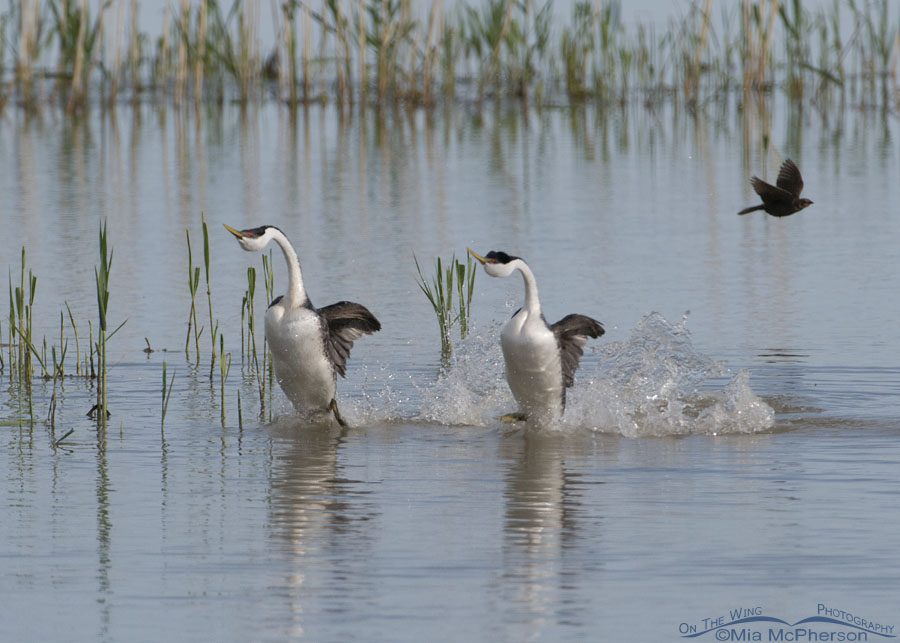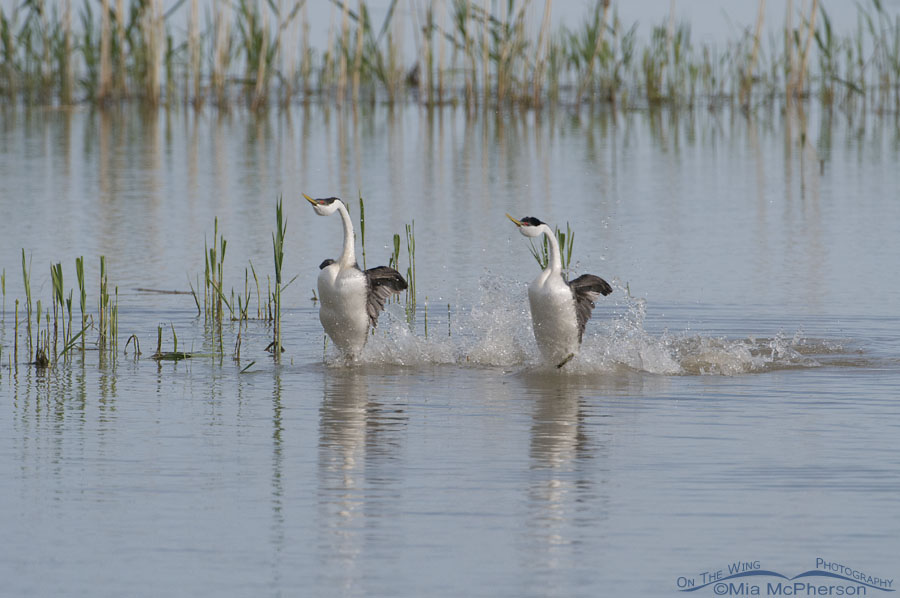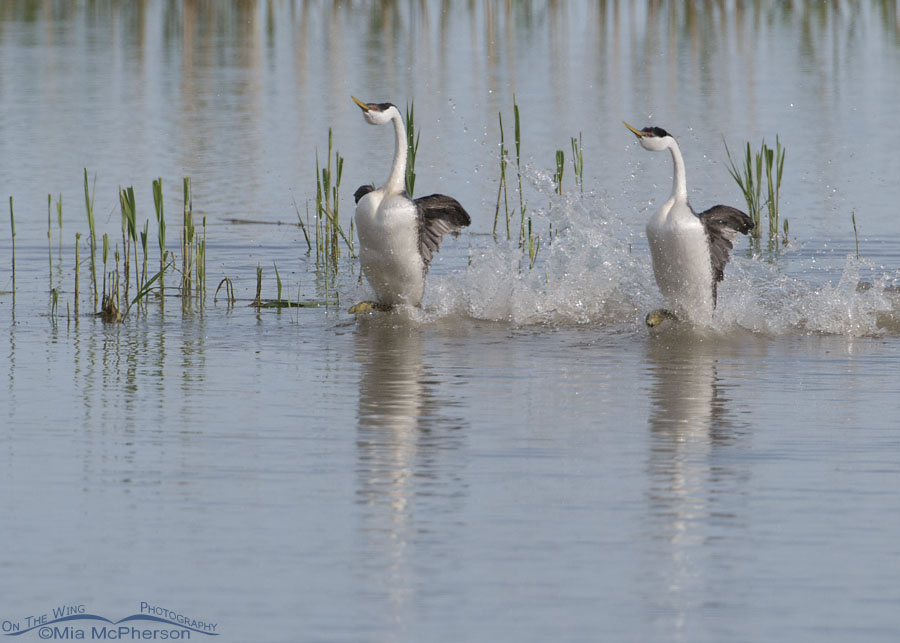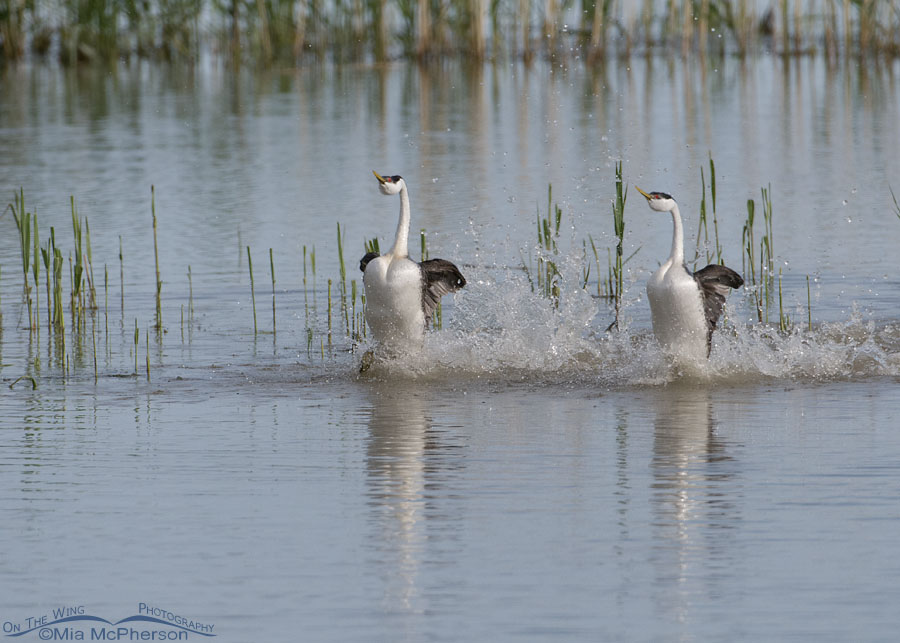 Rushing Western Grebes with a blackbird – Nikon D300, f6.3, 1/2500, ISO 500, Nikkor 200-400mm VR with 1.4x TC at 321mm, natural light
Rushing Western Grebes with a blackbird – Nikon D300, f6.3, 1/2500, ISO 500, Nikkor 200-400mm VR with 1.4x TC at 321mm, natural light
I photographed these rushing Western Grebes in early June of this year at Bear River Migratory Bird Refuge in Box Elder County. I had been keeping an eye on this pair while photographing other grebes that were closer and noticed that both of these birds were holding their heads low to the water with their necks out stretched which is called ratchet-pointing. I realized they were getting ready to rush and aimed my lens at them. (That is a female Yellow-headed Blackbird flying on the right side of the frame)
 Rushing Western Grebes – Nikon D300, f6.3, 1/2500, ISO 500, Nikkor 200-400mm VR with 1.4x TC at 321mm, natural light
Rushing Western Grebes – Nikon D300, f6.3, 1/2500, ISO 500, Nikkor 200-400mm VR with 1.4x TC at 321mm, natural light
The Rushing Ceremony is a courtship dance for Western (and Clark’s) Grebes that occurs during the mating season, it is amazing to watch these grebes become upright with their bodies completely out of the water and rush across the surface with the aid of their large feet. The sound of the splashing water seems to intensify the action.
 Rushing Western Grebes dancing across the water – Nikon D300, f6.3, 1/2500, ISO 500, Nikkor 200-400mm VR with 1.4x TC at 321mm, natural light
Rushing Western Grebes dancing across the water – Nikon D300, f6.3, 1/2500, ISO 500, Nikkor 200-400mm VR with 1.4x TC at 321mm, natural light
The male is on the left, female on the right, his chest is larger than hers. Normally I see Western Grebes courting earlier than these two birds, June seemed rather late but I’m super happy that I noticed the ratchet-pointing behavior these two exhibited or I might have missed photographing this interesting behavior. As a bird photographer I have learned that knowing my subject and its behavior helps me to anticipate their actions and that can lead to some wonderful action photos.
 Rushing Western Grebes 4 – Nikon D300, f6.3, 1/2500, ISO 500, Nikkor 200-400mm VR with 1.4x TC at 321mm, natural light
Rushing Western Grebes 4 – Nikon D300, f6.3, 1/2500, ISO 500, Nikkor 200-400mm VR with 1.4x TC at 321mm, natural light
Bear River Migratory Bird Refuge contains great habitat for Western and Clark’s Grebes and they are very abundant during the warmer months, right now their numbers are dropping because many of them have already migrated south. They’ll be back in the spring to dance across the water again.
Life is good.
Mia
Click here to see more of my Western Grebe photos plus facts and information about this species.


Beautiful photos. I’m jealous. We rarely get Westerns around here I’ve never seen a Clark’s at all. Even then they are just a pair passing through on their way north or south. and never stay more than a day or so.
Thank you for commenting Mark. I hope you will get a pair of Westerns to stick around for more time, they are such fascinating birds and I also hope that you get to see some Clark’s Grebes too!
wonderful captures Mia, I hope to get to see this behaviour and this bird in person someday
Dan, I hope that you get to see grebes dancing soon! Thank you for commenting.
Very nice, Mia!
Thank you Jim!
This is breathtaking. I find Grebes so fascinating!
Thank you Maria, I think grebes are fascinating too.
Awesome capture, it must be wonderful to watch them dance:)
Susan, it was wonderful to watch them dance! Thanks for your comment
Great action shots, Mia! You must have been really excited to get this.
Julie, I was very excited to get these images! Thanks for commenting.
Wow Mia, that is awesome!!
Great behavioral documentation!
Thanks Laurence!
Fantastic images, Mia!
Thank you Hilke.
Great shots. I love this behavior but haven’t captured as nice as this.
Thanks Earl, it took several years for me to get these shots too because Bear River NWR had been closed to the public for the summers of 2010 & 2011. Hopefully we won’t have that problem again and you will get your images of the grebes rushing!
Great catch Mia! The Western and Clark’s Grebes are a couple of my favorite water birds and we are lucky here in Northern California to have four lakes that support 76% of the total number of nesting grebes in California. They are Clear Lake, Eagle Lake, Lake Almanor and the Thermalito Afterbay of Lake Oroville. The first three have been designated as Audubon Important Bird Areas (IBA) and we have three Audubon chapters conducting an extensive monitoring project, finding ways to help increase their breeding success. We are finding that they are a complex species that require special attention. Some of the key threats they face during breeding season are boaters causing large wakes that break up their floating nests and inconsistent water levels on dam controlled lakes. Of course they also have the threat of being entangled in abandoned fishing line. Educating the public on these threats and how they can help abate them is critical to their future success. Plumas Audubon Society has an excellent reference page for anyone interested in helping Western and Clark’s Grebes in their area.
Larry, the grebes at Bear River are lucky in that boating isn’t permitted where they nest. Fishing is done on the Bear River itself and not in the units where they nest either. Thanks for listing the Plumas Audubon reference page for my viewers to see!
*Clap Clap*
wonderful!!
Thanks Judy!
Oh yes, beautiful. Your photographs are out of this world.
Thank you Bob, these birds were awesome subjects.
woow, a wonderfull action to shot :-)))
well play mia
Thanks Eric!
Great catch! Very interesting!
Thank you Beverly